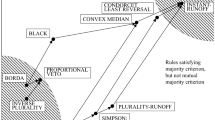Abstract
In this article, we provide a general model of “quaternary” dichotomous voting rules (QVRs), namely, voting rules for making collective dichotomous decisions (to accept or reject a proposal), based on vote profiles in which four options are available to each voter: voting (“yes”, “no”, or “abstaining”) or staying home and not turning out. The model covers most of actual real-world dichotomus rules, where quorums are often required, and some of the extensions considered in the literature. In particular, we address and solve the question of the representability of QVRs by means of weighted rules and extend the notion of “dimension” of a rule.
Similar content being viewed by others
References
Côrte-Real P, Pereira PT (2004) The voter who wasn’t there: referenda, representation and abstention. Soc Choice Welf 22: 349–369
Dougherty KL, Edward J (2010) The properties of simple vs. absolute majority rule: cases where absences and abstentions are important. J Theor Politics 22(1): 85–122
Dushnik B, Miller EW (1941) Partially ordered sets. Am J Math 63: 600–610
Felsenthal DS, Machover M (1997) Ternary voting games. Int J Game Theory 26: 335–351
Felsenthal DS, Machover M (1998) The measurement of voting power: theory and practice, problems and paradoxes. Edward Elgar Publishers, London
Freixas J, Zwicker W (2003) Weighted voting, abstention and multiple levels of approval. Soc Choice Welf 21: 399–431
Freixas J, Zwicker W (2009) Anonymous yes–no voting with abstention and multiple levels of approval. Games Econ Behav 67: 428–444
Herrera H, Mattozzi A (2010) Quorum and turnout in referenda. J Eur Econ Assoc (forthcoming)
Laruelle A, Valenciano F (2008) Voting and collective decision-making: bargaining and power. Cambridge University Press, Cambridge, NY
Maniquet F, Morelli M (2010) Approval quorums dominate participation quorums. EUI Working Paper 2010/13, Department of Economics, European University Institute, Florence, Italy
Szpilrajn E (1930) Sur l’extension de l’ordre partiel. Fundam Math 16: 1251–1256
Taylor AD, Zwicker WS (1992) A Characterization of weighted voting. Proc Am Math Soc 115: 1089–1094
Taylor AD, Zwicker WS (1993) Weighted voting, multicameral representation and power. Games Econ Behav 5: 170–181
Taylor AD, Zwicker WS (1999) Simple games: desirability relations, trading, pseudoweightings. Princeton University Press, Princeton, NJ
Uleri PV (2002) On referendum voting in Italy: yes, no or non-vote? How Italian parties learned to control referenda. Eur J Political Res 41: 863–883
Vermeule A (2007) Absolute majority rules. Br J Political Sci 37: 643–658
Zwicker W (2009) Anonymous voting rules with abstention: weighted voting. In: Brams SJ, Gehrlein WV, Roberts FS (eds) The mathematics of preference, choice, and order: essays in Honor of Peter C. Fishburn. Springer, Heidelberg, pp 239–258
Author information
Authors and Affiliations
Corresponding author
Rights and permissions
About this article
Cite this article
Laruelle, A., Valenciano, F. Quaternary dichotomous voting rules. Soc Choice Welf 38, 431–454 (2012). https://doi.org/10.1007/s00355-011-0538-1
Received:
Accepted:
Published:
Issue Date:
DOI: https://doi.org/10.1007/s00355-011-0538-1




